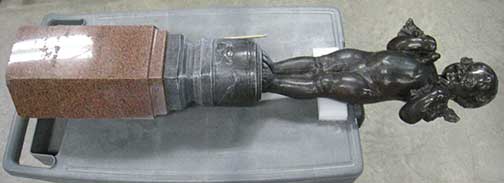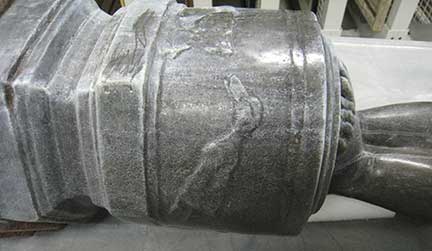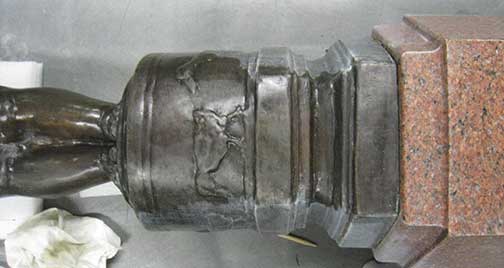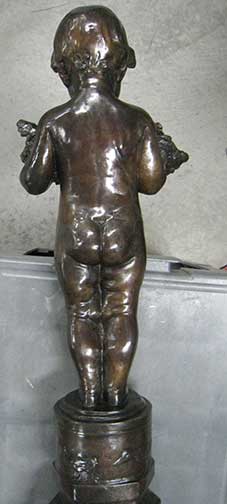I love “to-do lists.” There’s nothing more satisfying than checking off one completed task after another. More often than not, one item migrates from one month’s list to the next.
For many reasons, completing the annual cleaning of Edith Barretto Parsons’ sculpture Duck Baby is added to the list in November and remains on the list in June. It’s so easy to think all winter that plenty of time remains to get it prepared for the spring re-installation. Now the pressure is on. Sunny warm weather has arrived, and Woodson Art Museum visitors are enjoying the beautiful Museum grounds and gardens sans Duck Baby.
I’m trying to calculate how many times I’ve performed the annual cleaning of the bronze cherub. The sculpture was added to the collection in 1995; there were two trips to the Midwest Art Conservation Center in Minneapolis for more extensive treatments and one scrubbing by an intern. By my math, this will be my sixteenth year cleaning Duck Baby.
So what is the process, and why do I procrastinate each year?
It’s not rocket science, but it requires patience and is time consuming. The first step is to examine each and every crevice of the sculpture for bits of debris, and insect webs. Those are gently removed. Next is a thorough rinse with water. A gentle soap is added to a bucket, and with a soft bristle brush the sculpture is cleaned slowly from head to toe, followed by a final water rinse.
 To remove any remaining dirt and grit, a soft cloth is dipped in mineral spirits to wipe the sculpture’s entire surface. What remains – a white precipitate – is gently picked from the surface using an orangewood stick. This is time consuming. Most of the white substance is embedded in the wax layer; occasionally the wax erodes, and the material attaches to the metal layer as well. Removing that takes a gentle touch to prevent damage to the patina – the brown layer chemically applied to the surface of the bronze. If damaged, conservation treatment would be required.
To remove any remaining dirt and grit, a soft cloth is dipped in mineral spirits to wipe the sculpture’s entire surface. What remains – a white precipitate – is gently picked from the surface using an orangewood stick. This is time consuming. Most of the white substance is embedded in the wax layer; occasionally the wax erodes, and the material attaches to the metal layer as well. Removing that takes a gentle touch to prevent damage to the patina – the brown layer chemically applied to the surface of the bronze. If damaged, conservation treatment would be required.
 The most important step is last: adding the protective wax. Butcher’s Bowling Alley wax is the best choice for this climate. It’s important that the sculpture be warm to achieve a proper seal. Then, with a soft brush, the wax is applied in small areas, allowed to dry for twenty minutes, and vigorously buffed to a nice sheen.I purposely choose to blog about Duck Baby and the cleaning process to bring it to the top of my “to-do list.” As planned, I’ve completed a good part of the cleaning by today’s posting date.
The most important step is last: adding the protective wax. Butcher’s Bowling Alley wax is the best choice for this climate. It’s important that the sculpture be warm to achieve a proper seal. Then, with a soft brush, the wax is applied in small areas, allowed to dry for twenty minutes, and vigorously buffed to a nice sheen.I purposely choose to blog about Duck Baby and the cleaning process to bring it to the top of my “to-do list.” As planned, I’ve completed a good part of the cleaning by today’s posting date.
Taking its place on the list will be to repeat the procedure with the other twenty-six outdoor sculptures on the grounds. Now that’s a long “to-do list!”





